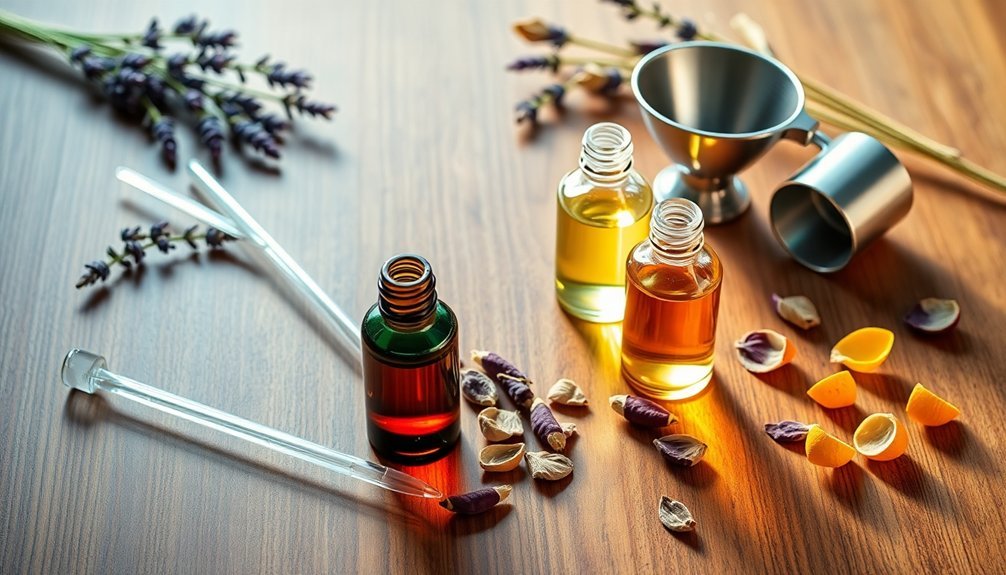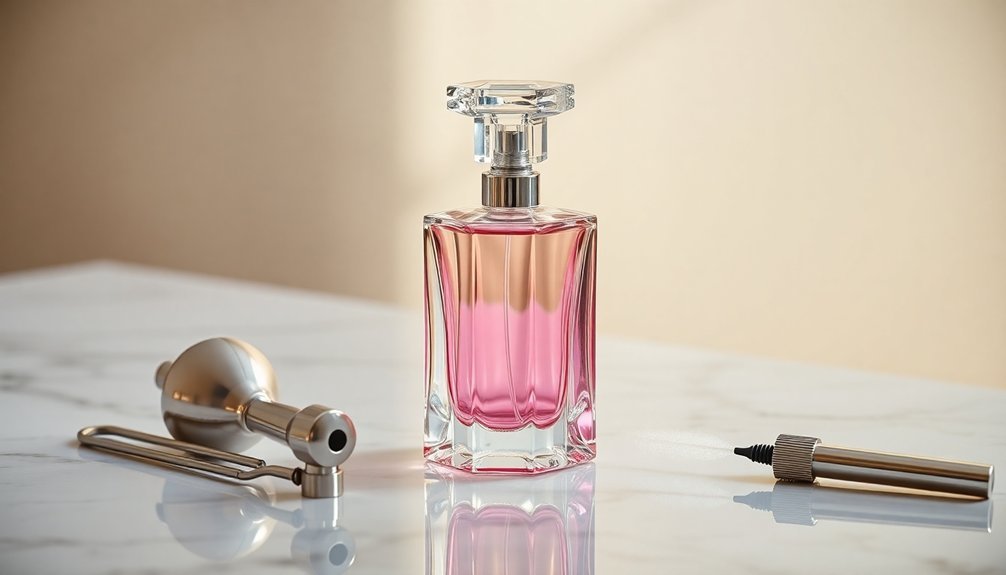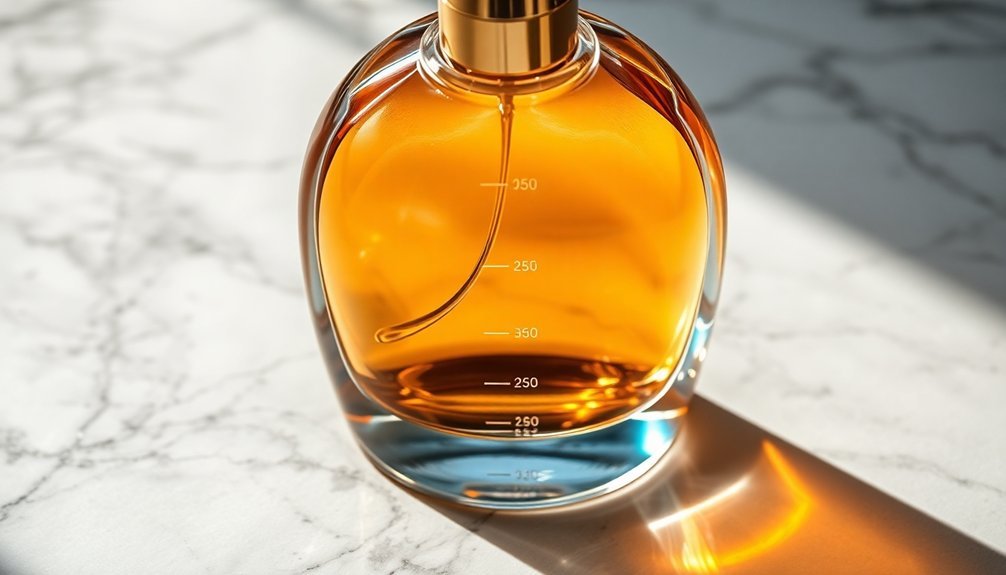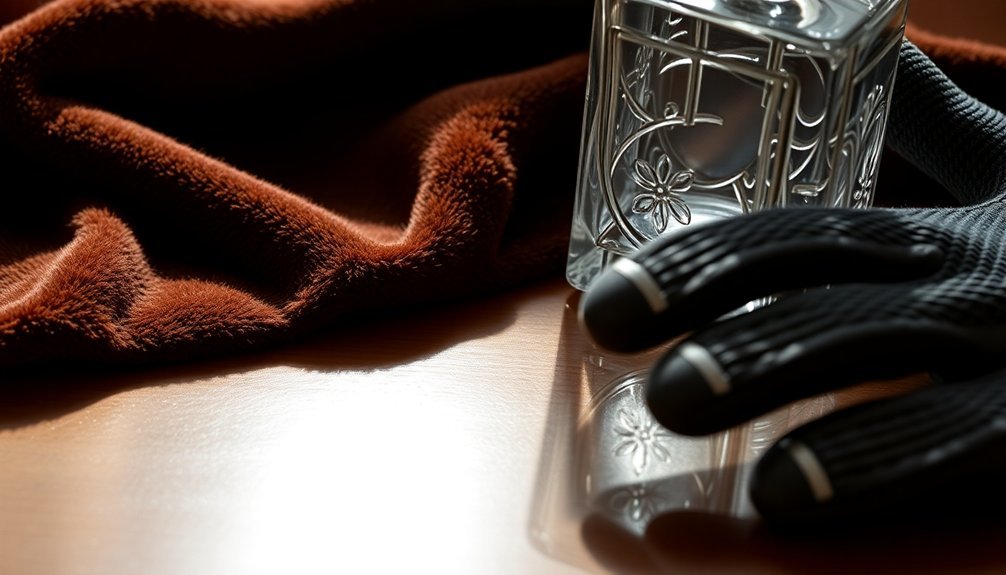A perfect perfume bottle starts with selecting the right size for your needs, from sample-sized (5-15ml) to standard (50-100ml). You'll want high-quality glass or crystal that's properly sterilized, along with a reliable spray mechanism that creates an ideal mist. Don't forget the decorative elements like etching, gilding, or crystal accents to enhance its beauty. Proper storage and maintenance will guarantee your bottle remains both functional and stunning throughout its journey.
Essential Tools and Materials for Your DIY Perfume Bottle

Crafting your own perfume bottle requires a well-organized collection of essential tools and materials.
Success in DIY perfume bottling starts with organizing the right tools and materials before your creative journey begins.
You'll need glass etching equipment, including a Silhouette Cameo Machine with its cutting mat and studio software. Don't forget safety gear like protective gloves and a scraper tool.
For the decorative process, you'll want etching cream, vinyl stencils, and transfer tape. Clean your bottles with rubbing alcohol before applying any designs. Once cleaned, ensure you position the stencil carefully on your bottle surface for the best etching results.
Keep basic tools like scissors and a weeder tool handy for vinyl work.
When it comes to preparing and creating the perfume itself, gather beakers, pipettes, funnels, and precise measuring tools.
Stock up on essential ingredients such as high-proof alcohol, essential oils, fragrance oils, distilled water, and glycerine. These components guarantee you'll create both a beautiful bottle and a lasting fragrance.
Selecting the Right Glass Container Size
When choosing a perfume bottle size, you'll need to contemplate both practical needs and personal preferences. Consider how frequently you'll use the fragrance and your lifestyle habits, particularly if you travel often. Many perfume bottles feature dispensing closures for precise application.
| Size Category | Volume | Best For |
|---|---|---|
| Sample | 5-15 ml | Testing new scents |
| Travel | 15-30 ml | Frequent travelers |
| Standard | 50-100 ml | Daily users |
If you're someone who enjoys trying different fragrances, smaller bottles (5-15 ml) might be your best choice. They're perfect for sampling and won't leave you committed to a single scent. However, if you've found your signature fragrance, larger bottles (100 ml) offer better value for money. Remember that stronger perfumes may require less product per use, so you might opt for a smaller size even with regular wear.
Sterilizing Your Perfume Bottle

Proper sterilization of your perfume bottle guarantees a clean, contamination-free vessel for your fragrance.
A sterile perfume bottle is essential for preserving your fragrance's purity and protecting it from unwanted contamination.
Before sterilizing, you'll need to ultrasonically clean your bottle and inspect it for any damage. Then, choose the sterilization method that best suits your bottle material.
For glass bottles, you can use boiling water or UV sterilization. If you're working with plastic containers, opt for chemical disinfection using alcohol-based solutions.
Don't forget to sterilize both the bottle and cap, keeping closures loose during the process to prevent damage.
After sterilization, fill your bottles while they're still hot to maintain sterility. A far infrared oven at 190 degrees can help ensure thorough drying and initial sterilization. Store them in a cool, dry place using protective materials to prevent breakage.
Remember to maintain proper ventilation throughout the process to guarantee the best results.
Preparing the Spray Mechanism
Setting up your spray mechanism correctly guarantees perfect perfume distribution and longevity. Before use, you'll need to understand how your atomizer works with the nozzle to create the ideal mist. The pump mechanism creates pressure that forces the perfume through specialized tubes, mixing it with air for maximum dispersion.
- Check your nozzle for any blockages or debris
- Test the pump mechanism by pressing it several times
- Confirm the valve system isn't loose or damaged
- Verify the atomizer tube reaches the bottom of the bottle
- Clean all components with hot water if necessary
If you're experiencing spray issues, don't force the mechanism. Instead, soak the nozzle in warm water to clear potential clogs.
Remember that proper maintenance of your spray mechanism will greatly extend your perfume bottle's functionality.
Testing for Leaks and Seals

Testing your perfume bottle for leaks guarantees both product preservation and packaging integrity. You'll need to employ various testing methods to verify your bottle meets industry standards like ASTM D5094. While helium testing offers superior accuracy, vacuum testing proves most practical for large-scale production.
| Method | Key Benefit | Best Use Case |
|---|---|---|
| Vacuum Testing | Visual confirmation | Batch testing |
| Pressure Decay | Small leak detection | Individual units |
| Helium Testing | Highest accuracy | Premium products |
Your testing process should start with filling bottles to one-third capacity and applying standardized torque to the caps. Using equipment like the LSST-01 or MFY-3 Smart Seal Tester, you'll need to maintain specific pressure levels for 10 minutes. Don't forget to conduct visual inspections after the vacuum release to spot any potential leakage signs.
Adding Decorative Elements to Your Bottle
Your perfume bottle's visual impact relies heavily on the decorative elements you choose, from intricate cap designs to thoughtfully crafted bases.
You'll find that combining strategic color choices and patterns, whether through glass tinting or surface treatments, can create a memorable aesthetic that reflects your brand's personality.
Materials like Surlyn, crystal, and metallic accents offer versatile options for enhancing your bottle's visual appeal while maintaining functionality.
Embellishments That Create Impact
Five key embellishment techniques can transform an ordinary perfume bottle into an enchanting work of art. When you're designing your bottle, consider how these decorative elements can create lasting impressions and enhance your brand's identity.
- Gilding with precious metals adds luxury and sophistication through metallic accents.
- Enameling protects while offering vibrant, eye-catching colors.
- Etching creates intricate, textured designs that catch light beautifully.
- Crystal or gemstone accents deliver a distinctive, high-end appearance.
- Custom caps and stoppers, from tasseled corks to artistic pumps, complete the design.
Your choice of embellishments won't just make your bottle beautiful – it'll help forge an emotional connection with customers and make your product stand out on store shelves.
Each decorative element serves as a silent ambassador for your brand's values.
Color and Pattern Choices
While embellishments add texture and depth to perfume bottles, the strategic use of colors and patterns serves as your primary tool for emotional storytelling.
Choose your bottle's color based on your fragrance's personality – blue for fresh aquatics, red for sensual florals, or white for cozy vanilla scents. Remember that colors trigger specific psychological responses and can even influence how people perceive your scent.
Consider your pattern choices carefully, as they'll help establish your brand identity and target audience.
Whether you opt for vintage-inspired designs or modern geometrics, make certain they align with your fragrance's character.
You'll want to maintain consistency between the color, pattern, and your scent profile to create a cohesive experience that resonates with consumers and enhances your perfume's perceived value.
Materials for Visual Appeal
Selecting the right decorative materials transforms an ordinary perfume bottle into a fascinating work of art.
You'll find countless options to enhance your bottle's visual appeal, from luxurious metals to hand-painted designs. Crystal and ceramic offer artistic expressions for high-end fragrances, while various glass types serve different aesthetic purposes.
Consider these essential decorative elements for your perfume bottle:
- Clear glass to showcase the perfume's natural color and purity
- Gold or silver accents for caps and embellishments
- Hand-blown glass for unique, artisanal appeal
- Etched or frosted surfaces for sophisticated texture
- Crystal components for brilliance and luxury
You can further customize your bottle through innovative techniques like acid etching, metallic coatings, or hand-painted designs.
Modern sustainable materials also offer eco-friendly alternatives without compromising visual appeal.
Proper Storage Considerations
Proper storage can make the difference between a perfume that lasts for years and one that deteriorates within months. You'll want to keep your precious fragrances away from direct light and heat while maintaining a consistent temperature around 60°F. Store your bottles upright in their original packaging, placed in dark drawers or cupboards.
| Storage Don'ts | Why It Matters | Impact on Your Perfume |
|---|---|---|
| Bathroom Storage | High humidity & temperature changes | Your fragrance will fade quickly |
| High Shelves | Risk of dropping & breaking | You'll lose your investment |
| Excessive Shaking | Causes unwanted oxidation | Your scent will change dramatically |
Remember to handle your bottles by their base or neck, and don't leave them exposed to air for long periods. If you're traveling, transfer your perfume to a protective travel-sized container to prevent damage.
Measuring and Marking Guidelines

You'll need precise calibration tools like graduated cylinders and digital scales to accurately measure your perfume volumes before bottling.
When marking fill lines, use a fine-tipped permanent marker or etching tool to create clear, consistent indicators on your bottles.
For the most accurate results, test your measurements using distilled water first, and mark your containers under good lighting while keeping the bottle at eye level.
Calibration Tools and Methods
When creating the perfect perfume, accurate measurements can make or break your final fragrance.
You'll need properly calibrated tools to guarantee your formulation meets industry standards and safety requirements. Regular maintenance and calibration of your measuring instruments are essential for consistent results.
Here's what you'll need for precise measurements:
- Calibrated pipettes for accurate liquid transfers with proper meniscus adjustment
- A precision scale that measures up to 0.01g for exact ingredient weights
- Calibrated burettes for controlled volume delivery
- Clean, well-maintained glassware to prevent contamination
- Proper safety equipment and documentation for handling ingredients
Always follow standard operating procedures when calibrating your tools, and remember to check your measurements against safety databases like Good Scents and IFRA.
You'll find that attention to calibration leads to more reliable and consistent perfume formulations.
Volume and Fill Lines
The accurate measurement and marking of perfume volumes requires mastering three vital elements: conversion factors, fill lines, and standardized bottle sizes.
You'll need to understand that 1 fluid ounce equals 29.57 ml, as this conversion is essential for international compliance.
When you're examining fill lines, look for clear markings that indicate proper volume levels – they can be metallic, printed, or embossed on the bottle. These markings aren't just decorative; they're important for preventing overfilling and ensuring product safety.
Standard bottle sizes typically range from 1-5 ml for samples to 200 ml for larger quantities, with the most common sizes being 30 ml, 50 ml, and 100 ml.
You'll find that bottles are filled slightly below capacity to account for liquid expansion.
Precision Marking Techniques
Since precise marking techniques form the foundation of professional perfume bottle design, mastering the right methods guarantees consistently high-quality results.
You'll need to choose between screen printing, hot stamping, UV printing, or laser engraving based on your specific needs and production scale.
Before applying any marking technique, you'll want to ascertain proper surface preparation and precise measurements.
Here are the essential steps for achieving perfect marks:
- Clean the bottle surface thoroughly with rubbing alcohol to remove oils and residue
- Use digital measuring tools and drafting rulers for exact placement
- Test your chosen technique on sample glass first
- Verify all measurements before final application
- Conduct quality checks throughout the marking process
Select the method that best matches your design complexity, production volume, and desired aesthetic finish.
Safety Precautions When Handling Glass

Proper safety precautions while handling glass can mean the difference between a smooth operation and a serious injury. You'll need to wear essential protective gear, including safety glasses, gloves, and steel-toed boots, and inspect them regularly for wear.
| Safety Essential | Key Action |
|---|---|
| Handling | Carry glass to the side with both hands |
| Teamwork | Use two people for large sheets |
| Storage | Keep glass in dry, secure locations |
When you're working with glass, maintain proper positioning and keep your workspace clear of obstacles. Don't carry glass under your arm or above your head. Make sure you've got a first aid kit nearby and you're familiar with emergency procedures. If you're using forklifts, verify that all racks are secure before moving materials. Regular training and clear communication between team members will help prevent accidents.
Creating Custom Labels and Tags
After ensuring safe glass handling practices, your attention should turn to creating custom labels that elevate your perfume bottle's visual appeal.
Select materials that align with your brand's identity, whether you're aiming for luxury with foil stamping or sustainability with recycled paper options.
Consider these essential label design elements:
- Choose between glossy, matte, or metalised finishes for desired impact
- Position your product name and fragrance details prominently
- Integrate your brand logo strategically for recognition
- Select shapes that complement your bottle design
- Apply appropriate printing methods like CMYK or UV for ideal results
You'll want to balance aesthetics with practicality, ensuring your labels not only look stunning but also withstand handling and storage conditions.
Digital printing offers cost-effective solutions for smaller batches, while hot stamping adds premium appeal.
Long-Term Maintenance of Your Perfume Container

To keep your perfume in pristine condition, you'll need to store your bottle in a cool, dark place away from direct sunlight and temperature fluctuations.
Your perfume bottle requires regular cleaning with a gentle vinegar-water solution, and you can add uncooked rice to help remove stubborn residue.
Don't forget to thoroughly dry the container before refilling it, as moisture can lead to mold growth and compromise your fragrance.
Proper Storage Techniques
While many perfume enthusiasts focus on selecting the perfect scent, proper storage plays an equally essential role in maintaining your fragrance's quality and longevity.
You'll want to keep your perfume in its original packaging and store it in a cool, dark place away from direct sunlight and humidity. For ideal preservation, maintain a consistent temperature around 41°F (5°C).
Here's what you need to remember for proper perfume storage:
- Keep bottles tightly closed to prevent oxidation
- Store in original boxes or air-tight containers
- Avoid plastic containers for long-term storage
- Use smaller travel atomizers for portable options
- Check regularly for signs of deterioration
Don't shake your perfume bottles unnecessarily, and minimize opening them to preserve their fragrance integrity.
Consider using dehumidifiers if you live in a humid climate.
Cleaning Your Bottle
Maintaining a pristine perfume bottle guarantees both its aesthetic appeal and functional longevity.
You'll need gentle cleaning materials like mild dish soap, white vinegar, and soft brushes to properly care for your bottle.
Mix equal parts vinegar and tepid water for stubborn residues, and add uncooked rice as a natural abrasive. Gently shake the mixture inside the bottle to reach all surfaces.
For intricate areas like the sprayer and bottle neck, use a small brush with gentle soap.
Never use hot water or harsh chemicals that could damage the glass or components.
After cleaning, let your bottle air-dry upside down to prevent moisture buildup.
Before refilling, ascertain it's completely dry and free of any lingering scents to preserve your new perfume's integrity.
Frequently Asked Questions
How Do Perfume Bottle Shapes Influence Consumer Buying Decisions?
You'll find that perfume bottle shapes trigger emotional responses and buying decisions. They'll signal luxury, romance, or modernity, while matching your personal style and intended use, ultimately influencing your purchase choice.
What Role Does Color Psychology Play in Perfume Bottle Design?
Colors in perfume bottles trigger your emotional responses and influence your buying decisions. You'll find warm tones suggesting passion, cool hues conveying freshness, and metallic finishes signaling luxury, all strategically chosen to attract you.
Can Perfume Bottle Designs Be Legally Protected Through Patents?
Yes, you can protect your perfume bottle designs through design patents, which safeguard their unique aesthetic features. They'll typically last 15 years in the U.S., giving you exclusive rights to your design.
How Do Different Cultures Interpret Various Perfume Bottle Designs?
You'll notice cultures interpret perfume bottles differently: Middle Eastern designs value ornate luxury, Asian cultures prefer minimalism, Europeans embrace sophistication, while interpretations often reflect local traditions, symbols, and aesthetic preferences.
What Environmental Impact Do Luxury Perfume Bottles Have on Waste Management?
Your luxury perfume bottles greatly impact waste management due to their mixed materials. They're hard to recycle, contribute to landfill waste, and create microplastic pollution when their plastic components break down.





Leave a Reply